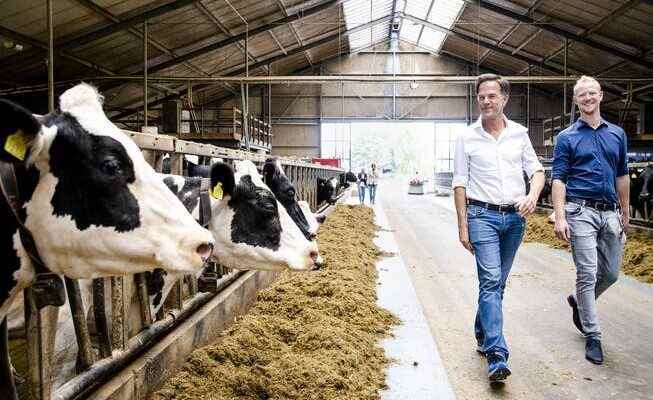The government in The Hague wants to take the wind out of the sails of angry farmers with a comprehensive offer of dialogue. The targeted reduction in nitrogen emissions in agriculture threatens many farms.
President Mark Rutte visiting a farm in Friesland.
Mark Rutte seems to have lost the good mood that characterizes him recently. When the 55-year-old Dutch Prime Minister visited a dairy farm in Friesland on Thursday, the obligatory big smile was not missing. But it was different than usual when the right-wing liberal politician shows himself in front of the television cameras.
Rutte, dressed casually in jeans and a white shirt rolled up, looked uncharacteristically serious as farmer Anton Stokman lamented his distress at the government’s plans to drastically cut nitrogen pollution in agriculture.
He came to listen, Rutte said, rather taciturnly. But he later took to Twitter. The reduction of nitrogen emissions brings about profound changes. Therefore, the government remains in close contact with the farmers. “Because it is a joint dialogue that takes us forward,” wrote Rutte.
In fact, the Netherlands has recently experienced a wave of angry and violent protests against the nitrogen plans. Enraged farmers used tractors to block traffic routes and access roads to supermarkets, threw heaps of dung on the streets or set fire to highways with bales of straw and car tyres. Dutch flags hung upside down appeared in many places as a sign of protest.
A Minister for “Nature and Nitrogen Policy”
The dialogue started on Friday with a four-hour meeting between Rutte and three cabinet members with representatives of agricultural interest groups. The fact that the meeting was to be chaired by former Interior Minister Johan Remkes in Utrecht was initially kept secret, apparently for fear of demonstrating farmers.
The government sees itself forced to take intervening steps, partly because of the requirements of the European Union. This is also why the coalition of right-wing liberals (VVD), left-liberals (D66), Christian Democrats (CDA) and the small Calvinist Christian Union (CU) had a party friend of Rutte’s, Christianne van der Wal, specifically as Minister for “Nature and Nitrogen Policy” with the dossier entrusted.
The aim is to reduce emissions of nitrogen oxide and the ammonia contained in fertilizer by 50 percent by 2030. The government had already decided on a number of measures to reduce the substances that are harmful to the environment, pollute the soil and also contribute to the warming of the earth’s atmosphere. As a rule, the maximum speed on motorways is 100.
When van der Wal specified the government’s plans with the help of a map in June, a storm of indignation broke out. The map showed extensive deep red patches – areas where emissions are expected to fall by at least 70 percent. In plain language, this means that only around 30 percent less cattle should be kept there – for many farms in particularly intensive agriculture that would be tantamount to the end.
The fact that not only agriculture – with a share estimated at 40 percent – but also industry and transport are responsible for nitrogen pollution was somewhat overlooked. This also applies to the fact that an estimated 40 percent of emissions enter the country across borders.
The government is now hoping that ex-Interior Minister Remkes can calm things down. Of course, he let it be known that he was not a “mediator”, but merely a “neutral conversation leader”. The reluctance is no accident. Even LTO Nederland, the largest interest group for farmers, had resisted a meeting for a long time.
LTO President Sjaak van der Tak only agreed to participate after Rutte assured that there would be “no taboos”. Even before the meeting in Utrecht, it was clear that the government was reluctant to make far-reaching concessions to farmers. Minister van der Wal repeated Rutte’s words from the previous day that it was about listening. The important thing is that there are talks. “That’s how we do it together in the Netherlands, together at one table,” said the minister.
The meeting in Utrecht should only be the start. A meeting with representatives of nature and environmental protection organizations will follow shortly. Then it is the turn of representatives from the twelve Dutch provinces responsible for implementing the plan. Remkes then wants to take stock.
The nitrogen problem comes at an inopportune time for the “Teflon mark”, as Rutte is often called, not least because of the smooth handling of sensitive issues. Last Tuesday, the head of government was in office for exactly 4,311 days – longer than the previous record holder, Ruud Lubbers (CDA), who was in office from 1982 to 1994.
Does Rutte pull his head out of the noose again?
He has often proven how agile Rutte can be. In 2010 he came to power at the head of a minority government of VVD and CDA, tolerated by right-wing populist Geert Wilders’ Party for Freedom (PVV). In 2012 he formed a coalition of VVD and Social Democrats (PvdA). He has led a centre-right alliance since 2017.
However, the nitrogen plan has also carried the strife into its own party. Immediately after the detailed plans were announced, a slim majority of 51 percent voted against at a congress of the VVD, which is not exactly a farmers’ party. It was assumed that many members wanted to express their dissatisfaction with Rutte’s administration with the vote.
Rutte said after the vote that the plans would “of course” remain unchanged. Eight weeks later – at the beginning of the dialogue with the farmer representatives – it looks as if he will have to rely on suppleness and agility again.
It is not yet clear whether he will be able to do this. On Friday, after the meeting, Remkes only allowed himself to be elicited to point out that the controversial overview map should not be understood in such a way that every farmer would have compelling consequences for his business.
